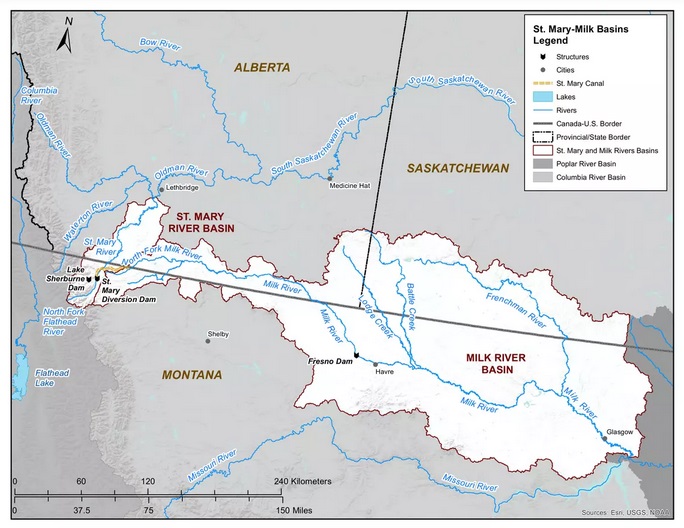Author: Joe McFarland, Schulich School of Engineering

The International Joint Commission is hoping to modernize the Boundary Waters Treaty, which regulates waterways like the Milk and St. Mary rivers.
When the Boundary Waters Treaty governing waters straddling the U.S.-Canada border was drawn up more than a century ago, concerns such as climate change and replacing the infrastructure were totally unknown.
Now, a Schulich School of Engineering professor and researcher is heading up an independent cross-border study into updating the oldest piece of legislation governing the use of water that runs between the two countries.
Dr. Alain Pietroniro, PhD, is an internationally respected expert in hydrology and sustainable water systems, having spent more than three decades studying water resources engineering. Through his involvement with the International Joint Commission, Pietroniro is co-chairing a study of the treaty, to examine the options of improving access to study the shared waters of the St. Mary and Milk Rivers, which cross the Alberta-Montana border.
He and his Canadian colleagues are building teams to respond to important questions about how water is valued and shared between the two countries.
"Over the years, there have been a number of initiatives taken to review the way in which water is shared along the boundary in that basin," he says. "As we face the present and expected impacts from climate change and aging infrastructure, it's important that we review water management options in the region while maintaining our treaty obligation."
A brief history
The St. Mary and Milk Rivers have been key waterways for communities and agricultural lands on both sides of the border in southern Alberta and northern Montana.
In the late 1800s, disputes over the waters shared by the two nations became more frequent.
At one point, Pietroniro says, the U.S. built canals for diverting irrigation water, while Canada responded by digging their own canal to bring that very same water back into the original basin escalating tensions between the two countries.
The dispute is viewed as one of the reasons for the signing of the Boundary Waters Treaty in 1909, not just for water rights, but also to ensure fair and beneficial use of water across the border. The treaty covered the two waterways, as well as others.
By signing the treaty, both countries agreed to sharing the water and not to pollute any cross-jurisdictional water if it could hurt people or property in the other country. Both countries would also have to agree on certain projects and allocation of water and water levels between both countries' lakes and rivers that crossed or straddled the border, such as Lake Michigan.
The first treaty established the International Joint Commission (IJC) to help the two countries carry out the provisions.
In 1921, an IJC order was signed with more detailed instructions on how the measurement and sharing of water from the St. Mary and Milk Rivers would be managed by each country.
Addressing today's challenges
A century later, both federal governments agreed to launch a new study to improve access and management of water within the two rivers.
Pietroniro says the new four-year study will focus on water measurement data and calculations used to determine the amount of water each country receives, as well as possible options to improve how water is managed within the basin.
He says that could include a review of infrastructure like canals and reservoirs, as well as the "downstream" impacts of ecological, economic, cultural and recreational resources.
It also opens an opportunity to talk about something that isn't included in the original treaty.
"While the water rights of Indigenous Nations were acknowledged by those negotiating the order, they were not reflected in it," says Pietroniro, who was recently named the Tier 1 NSERC Canada Research Chair in Sustainable Water Systems in a Changing Climate.
UCalgary's leadership role
A total of six people make up the independent board, appointed by the IJC last November, with three members coming from each Canada and the U.S.
Pietroniro co-chairs the panel alongside John Kilpatrick, director of the Wyoming-Montana Water Science Center at the U.S. Geological Survey.
Another UCalgary connection to the study will be Dr. Fred Wrona, BSc'77, PhD'82, professor and Svare Research Chair in Integrated Watershed Processes. He will serve as the special liaison and co-chair of a Canada-U.S. government forum, providing regular updates between the researchers, Indigenous communities, the IJC and related government departments and agencies.
Other UCalgary experts involved in the technical working groups of the study include: Dr. Tricia Stadnyk, PhD (Tier II Canada Research Chair, Hydrological Modelling); Dr. Kerry Black, PhD (Tier II Canada Research Chair, Integrated Knowledge, Engineering and Sustainable Communities); and Dr. Kelly Munkittrick, PhD (Campus Alberta Innovates Program Research Chair in Aquatic Ecosystem Health).
Also on the study board is Dr. Dena McMartin, PhD, vice-president (research) and fellow water resources engineer at the University of Lethbridge.
To put their report together, the group will be tapping into the different engineering, geography and science experts around their respective campuses, as well as the Alberta and Montana governments, Environment and Climate Change Canada, the U.S. Geological Survey, and Indigenous communities in the basin, amongst many others.
"At UCalgary, we are taking a leadership role in this important binational initiative," Pietroniro says. "This really is an opportunity to work together to manage our most valuable natural resource."
The study report, with its recommendations, will be sent to the IJC in June 2025. The two federal governments are expected to receive the final report later that year.













